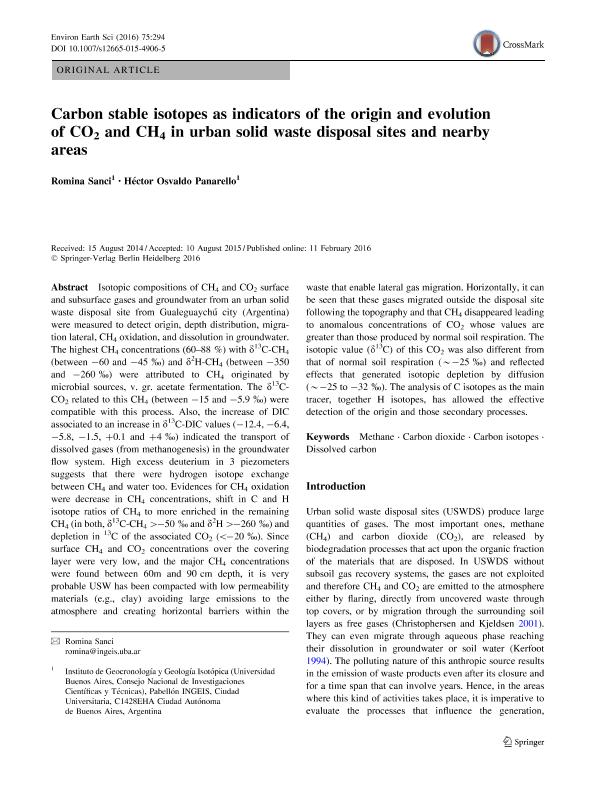Mostrar el registro sencillo del ítem
dc.contributor.author
Sanci, Romina

dc.contributor.author
Panarello, Hector Osvaldo

dc.date.available
2018-05-09T17:41:59Z
dc.date.issued
2016-02
dc.identifier.citation
Sanci, Romina; Panarello, Hector Osvaldo; Carbon stable isotopes as indicators of the origin and evolution of CO2 and CH4 in urban solid waste disposal sites and nearby areas; Springer; Environmental Earth Sciences; 75; 4; 2-2016; 75-94
dc.identifier.issn
1866-6280
dc.identifier.uri
http://hdl.handle.net/11336/44635
dc.description.abstract
Isotopic compositions of CH4 and CO2 surface and subsurface gases and groundwater from an urban solid waste disposal site from Gualeguaychú city (Argentina) were measured to detect origin, depth distribution, migration lateral, CH4 oxidation, and dissolution in groundwater. The highest CH4 concentrations (60–88 %) with δ13C-CH4 (between −60 and −45 ‰) and δ2H-CH4 (between −350 and −260 ‰) were attributed to CH4 originated by microbial sources, v. gr. acetate fermentation. The δ13C-CO2 related to this CH4 (between −15 and −5.9 ‰) were compatible with this process. Also, the increase of DIC associated to an increase in δ13C-DIC values (−12.4, −6.4, −5.8, −1.5, +0.1 and +4 ‰) indicated the transport of dissolved gases (from methanogenesis) in the groundwater flow system. High excess deuterium in 3 piezometers suggests that there were hydrogen isotope exchange between CH4 and water too. Evidences for CH4 oxidation were decrease in CH4 concentrations, shift in C and H isotope ratios of CH4 to more enriched in the remaining CH4 (in both, δ13C-CH4 >−50 ‰ and δ2H >−260 ‰) and depletion in 13C of the associated CO2 (<−20 ‰). Since surface CH4 and CO2 concentrations over the covering layer were very low, and the major CH4 concentrations were found between 60m and 90 cm depth, it is very probable USW has been compacted with low permeability materials (e.g., clay) avoiding large emissions to the atmosphere and creating horizontal barriers within the waste that enable lateral gas migration. Horizontally, it can be seen that these gases migrated outside the disposal site following the topography and that CH4 disappeared leading to anomalous concentrations of CO2 whose values are greater than those produced by normal soil respiration. The isotopic value (δ13C) of this CO2 was also different from that of normal soil respiration (~−25 ‰) and reflected effects that generated isotopic depletion by diffusion (~−25 to −32 ‰). The analysis of C isotopes as the main tracer, together H isotopes, has allowed the effective detection of the origin and those secondary processes.
dc.format
application/pdf
dc.language.iso
eng
dc.publisher
Springer
dc.rights
info:eu-repo/semantics/openAccess
dc.rights.uri
https://creativecommons.org/licenses/by-nc-sa/2.5/ar/
dc.subject
Methane
dc.subject
Carbon Dioxide
dc.subject
Carbon Isotopes
dc.subject
Dissolved Carbon
dc.subject.classification
Meteorología y Ciencias Atmosféricas

dc.subject.classification
Ciencias de la Tierra y relacionadas con el Medio Ambiente

dc.subject.classification
CIENCIAS NATURALES Y EXACTAS

dc.title
Carbon stable isotopes as indicators of the origin and evolution of CO2 and CH4 in urban solid waste disposal sites and nearby areas
dc.type
info:eu-repo/semantics/article
dc.type
info:ar-repo/semantics/artículo
dc.type
info:eu-repo/semantics/publishedVersion
dc.date.updated
2018-04-13T18:11:41Z
dc.journal.volume
75
dc.journal.number
4
dc.journal.pagination
75-94
dc.journal.pais
Alemania

dc.journal.ciudad
Berlin
dc.description.fil
Fil: Sanci, Romina. Consejo Nacional de Investigaciones Científicas y Técnicas. Oficina de Coordinación Administrativa Ciudad Universitaria. Instituto de Geocronología y Geología Isotopica. Universidad de Buenos Aires. Facultad de Ciencias Exactas y Naturales. Instituto de Geocronología y Geología Isotópica; Argentina
dc.description.fil
Fil: Panarello, Hector Osvaldo. Consejo Nacional de Investigaciones Científicas y Técnicas. Oficina de Coordinación Administrativa Ciudad Universitaria. Instituto de Geocronología y Geología Isotopica. Universidad de Buenos Aires. Facultad de Ciencias Exactas y Naturales. Instituto de Geocronología y Geología Isotópica; Argentina
dc.journal.title
Environmental Earth Sciences
dc.relation.alternativeid
info:eu-repo/semantics/altIdentifier/doi/http://dx.doi.org/10.1007/s12665-015-4906-5
dc.relation.alternativeid
info:eu-repo/semantics/altIdentifier/url/https://link.springer.com/article/10.1007%2Fs12665-015-4906-5
Archivos asociados
